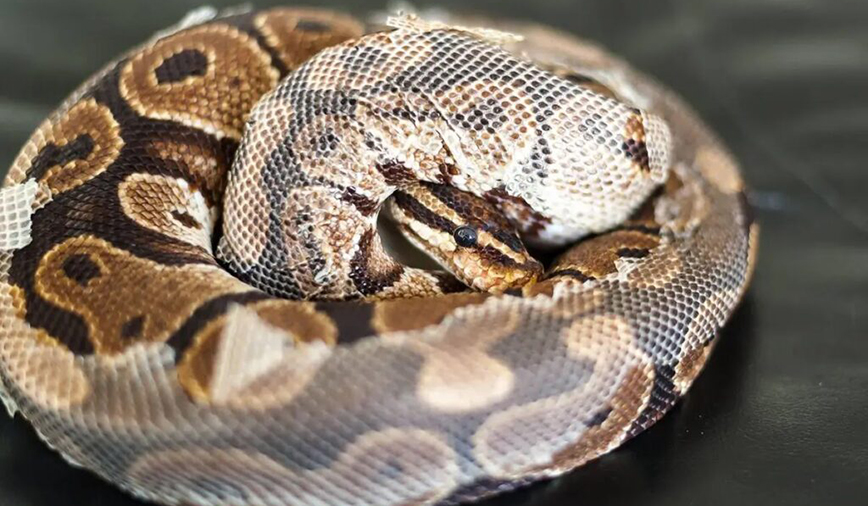Who doesn’t love having a ball?
Well, my friend Suzi, for one.
Not that she’s a stick in the mud. Far from it! But the kind of ball we’re talking about isn’t a fun-filled, action-packed afternoon, nor an evening of delightful revelry.
Nope, this sort of ball is Python regius, the ball python.
Suzi’s story started last fall, as she was working in her yard. Amongst the leaves on the ground, near the foundation of her house, was a hunk of shed snakeskin.
Now Suzi, fearless on many counts, is not a big fan of snakes. But, bless her heart, she knows I am. In a somewhat dismayed tone, she told me of her find, describing it as “big,” and said she’d save the skin for me.
She might as well have told me she found a can of gold coins in her yard—that’s how excited I was.
Like a kid at Christmas, my mind raced with possibilities. We don’t really have a lot of “big” snakes native to our area, so the list of potential species was pretty small. Garter snakes, Thamnophis sirtalis and T. radix, are our most common local snakes. While most are quite small, I’ve seen some mature females that were every bit of three feet in length. Then there’s the northern water snake, Nerodia sipedon, which is probably our thickest-bodied snake, and the western fox snake, Pantherophis vulpina, which at 4+ feet is probably our longest.
As I recall, I babbled on a bit about those various prospects while Suzi listened politely. My goal of identifying a species was little different from hers, which I’m thinking was to hand over the skin and get on with her life.
Circumstances and schedules being what they were, several months passed before Suzi and I were able to get together and conduct the transaction. Finally, a week ago last Sunday at—appropriately—the Creek Bend Nature Center in St. Charles–Suzi at long last handed over the Ziploc bag of precious skin.
My first thought, on holding it up to the light, was, “Whaaat?”
The scale pattern was unlike any of our local species. The dorsal scales were small and had no keels, or ridges. Even more puzzling, the belly scales were almost circular, not rectangular like those of our natives.
I was beginning to wonder if maybe the skin was that of a lizard, not a snake, when I held it up to the light and saw a faint pattern
of light and dark circles—exactly what you’d expect to see on the shed skin of a ball python.
But ball pythons, native to West and Central Africa, aren’t exactly the kinds of snakes you’d expect to see in St. Charles.
Topping out at about 5 feet in length, ball pythons get their common name from their habit of rolling up into a ball when threatened. This endearing trait, coupled with a generally docile nature, has made these snakes common in the pet trade. Although many now are bred here in the United States, a large number still are being caught in the wild and imported. (Note to prospective ball python owners: Ask about your snake’s origins. Captive-bred individuals are generally hardier, and their purchase does not have an impact on African ecosystems.)
Sitting there in my car, looking at the scrap of ball python skin, my mind once again raced with possibilities. Did someone let their pet snake go? Did one escape by accident? Was it living somewhere close by? Ball pythons are terrific burrowers. Was there any way at all it could have found a way to dig down and survive this long, cold winter? Should I try to go and look for it at Suzi’s house this spring?
I saw my friend again the other night. I had told her previously of my thoughts on the snake, but she had yet to share hers. Instead of going with the idea of a snake living in her yard, potentially surviving in a burrow near her foundation, Suzi offered another completely plausible explanation: A student at Lincoln Elementary School, which is only a few blocks from her house, could have taken the skin for show-and-tell, then accidentally lost it on his or her way home from school.
“It was pretty breezy the day I found it,” Suzi noted, in a hopeful tone.
At this point, it’s really not possible to know with 100% certainty where the skin came from, or how it came to be in Suzi’s yard. But one thing is for sure. When the weather finally warms up, and sunny days return, I’m going include Suzi’s neighborhood in my walking routine. I’ll bring my dog Joey, and the two of us will keep our eyes peeled. And maybe, just maybe, we’ll have ourselves a ball.
Pam Otto is the manager of nature programs and interpretive services at the Hickory Knolls Discovery Center, a facility of the St. Charles Park District. She can be reached at 630-513-4346 or potto@stcparks.org.

